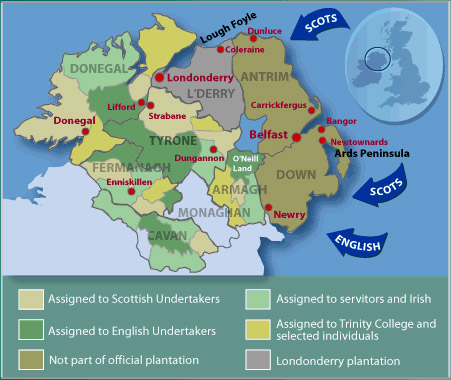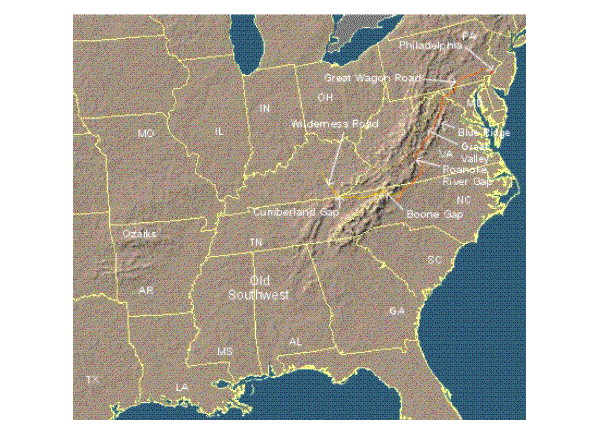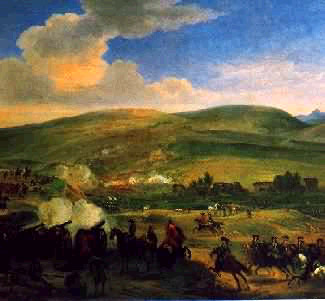|
Our Direct
McCurdy Line within
the Swope
asendancy tarried but briefly in Ireland, arriving 1666 from the Isle
of Bute, Scotland and emmigrating about 1720 to America in the form of
James
McCurdy who was born Rathlin Island, but is later found
in Lancaster Co., Penna. Despite brief residence in Ireland, many
of James McCurdy's siblings & uncles remained there, leaving
us with a large collection of very distant McCURDY cousins in Ireland's
north. Specific locations of residence for our McCURDY line of Ireland
include Ballintoy, Antrim, Ireland and Raithlin Island, Antrim, Ireland.
See The Ulster Plantation . See Irish surnames
direct via McCurdy marriage CREIGHTON,
STEWART,
LAUGHLIN
, COOKE.
The Williamson line married into our
Howard line very shortly after arrival to America in 1917, and so is part
of the Howard Ascendancy .
Our earliest European Williamsons are associated with Bailieborough, Co
Cavan, Ireland, in the Republic of Ireland's north central region
. It is here that evidence of the adult Samuel Williamson is found from
1796. Although it is unknown where Samuel Williamson was born in
1769, he apparantly had a brother William whose descendant resides today
in Malvern, England. GG Grandaughter Sarah Williamson emmigrated to the
US in 1917 via Ellis Island, was born in Cliffin, Killinkere, Virginia,
County Cavan in 1888, and she left Ireland with her brother William
David ' Willie ' Williamson , but he was unhappy in the New World
& returned across the water. Another brother, Edward Booker
Williamson , emmigrated to Vancouver , BC, Canada at an unknown date: He
was a fireman, and he died there in 1945 leaving several children. Willie,
the brother who emmigrated with Sarah but who returned, was the father
of our Irish cousins of County Meath whom we have visited and who
visited us. Our cousins of Vancouver appear lost to us, and I welcome contact
from anyone associated with the Williamson line of that place.
This family may be part of the Ulster Plantation.
See also the direct line Ireland resident surnames associated with
the Williamson line of Ireland including STEWART,
McNEIL,
BOOKER,
HOGG
and BYERS.
|
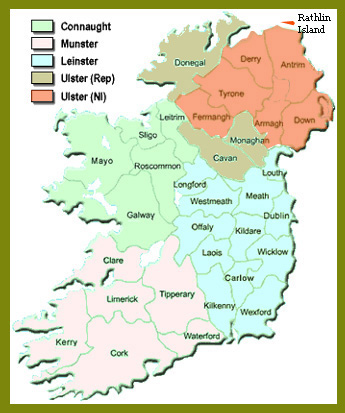 |
James
LOGAN, a Pennsylvania immigrant found in our Howard
Ascendancy , emmigrated with William Penn in 1699. He was born
in 1674 in Armagh,, Ireland where his family remained until he was
a teenager, making Ireland his country of birth and formation. Logan's
father was of Scottish descent and a Quaker
of East Lothra, Scotland. According to John W Jordan, " in March,
1671,
the father removed to Lurgan, county Armagh, Ireland,... [and remained
there] until the landing of William of Orange in 1689, when he removed
with his family to Edinburgh.... and soon after to Bristol, England....
He had married while in Scotland, Isabel, daughter of James Hume, a young
son of the House of St. Leonardís in the south of Scotland, by his wife
Bertha Dundas, sister to the Laird of Dundas, of Didiston, about eight
miles from Edinburgh, and a descendant of Lord Panmure. James Logan wrote
' The Earl of Murray assisted my grandfather to carry off my grandmother.'
" 1
The above excerpt places James Logan's ascendancy among the Peerage
of Scotland and England, and so is found in the
Royals and Peers pages herein. James Logan , born in Lurgan
Ireland in 1674, emmigrated to Philadelphia with William
Penn in 1699. Logans' fortune as Penn's secretary allowed him to advance
his skill and circumstance. Logan became colonial Pennsylvania's most powerful
person. His son William Logan
continued in Penn Family service, and was also vitally significant to Pennsylvania
history.
See Scotland and our Scots, also Our
Peers and Royals, and Our Quakers
. See as well Philadelphia and our Ancestors there,
in the Pennsylvania Chapter of Volume I;Our American Immigrants. |
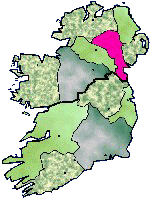 |
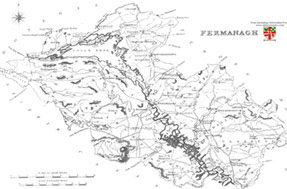 |
William
CREIGHTON found in our Swope asendancy
is without known forebear but is said to have been born "1710 , apparantly
of County Fermanagh, Ulster, Ireland Ancestry"2
William Creighton's will is found in Lancaster Co., Pennsylvania: His
daughter married into the McCurdy line of that place. His suggested placement
in the region of the Ulster plantation, as well
as his precense in the society of the Scot-Irish of Lancaster County, Pennsylvania,
suggests a Scottish ascendancy although some native Irish apparantly anglicized
phoenetically similar clan names to Creighton as a result of the
period of Scots immigration to Ireland and the name's prominence [See Gateway
to the Creighton study at the origin
of the Creighton Name page].
Click Map to Enlarge
|
Direct to the The
Williamson Line of Ireland are surnames McNEILL,
(associated with County Antrim) , BOOKER, HOGG and BYERS(earliest
currently known members of which are County Cavan residents) . The
Williamson line is currently confined to County Cavan, Ireland,
from year 1796.
The BOOKERs are limited to a Williamson bride's name;
Mary , of whom nothing further is known. Mary (Booker) Williamson's
son Edward Booker Williamson inherited from his uncle and lived at the
farm called Cliffin, in Kilinkere, Co Cavan with his bride Mary BYERS,
dtr of Sarah HOGG and Robert
BYERS.
This Robert Byers may
be the Robert Byers mentioned in the Tithe Applotments of 1834 for
Coranedan [Corraneden] , Killinkere Parish , Co Cavan.
The McNEILL, BOOKER, HOGG and BYERS are protestant in their marriages.
See the Plantation.of Ulster. See the dedicated
page County Cavan, and Bailieborough
within |
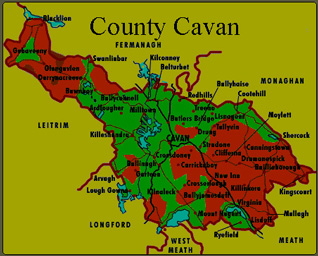 |
| LAUGHLIN of Ireland. Margaret LAUGHLIN
, a bride in the McCurdy line of Ireland,lived
with her husband Daniel (styled 'Of Ahoghill') McCurdy (1677-1741) at Ahoghill
, Antrim, found in the western portion of the map at right. Her antecedants
are not defined, but her son Pathrick married "his cousin" Mary Margaret
Laughlin, suggesting that Patrick's mother , Margaret LAUGHLIN, had
a brother and extended family in the region.
Polly COOKE , also a a bride in
the McCurdy line of Ireland, and found in our Swope
asendancy married James McCurdy (1706-1770) of Rathlin
Island, Antrim County, Ireland. Blanchard informs that Polly emmigrated
with him from Ireland and to Pennsylvania about 1727. Her birth family,
place and date of birth are not known.
Our STEWART line of Ireland holds but brief
relevance to that Isle. It is limited to two generations, being subjugated
via marriage to the McCurdy line of Ireland.
Margaret Stewart married her McCurdy groom in 1667, and lived with her
Scot born and Ireland immigrated McCurdy husband at the Cairn , Ballintoy,
Antrim, Ireland. Like the McCurdys, Margaret Stewart's pedigree involves
ancient residence on the Isle of Bute, Scotland. Eight generations above
Margaret STEWART , who emmigrated to Ireland with her father, is the first
of several Stewart Sherriffs of Bute. That first Stewart Sheriff of the
Isle of Bute was the illegitimate son of Robert II Stewart, first of the
Stewart kings, through which Our Ancient Irish
are gained.
See too Scotland and our Scots and
Our
Peers and Royal pages.
The McNEIL surname of the Howard
Ascendancy is limited to Isabelle McNEILL who married
into the Williamson family of Ireland. She is
said to have been born 1823 in Aghalee, Antrim, Ireland. It
is known she married her Williamson groom 1850 and in Corglass Presbyterian
church, outside Bailieborough, County Cavan, allowing the possibility
that her as yet undiscovered birth family emmigrated to that place sometime
before her marriage.
Click Map to Enlarge
|
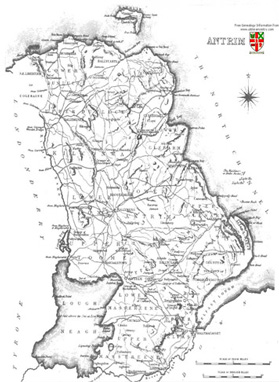 |
The MOORE , surname also Swope
asendancy relevant , is known only through Martha Moore, born
in the late 18th century and marrying into the McCurdy family of Pennsylvania's
Scots Irish settled Manor of Maske region. Relationship of this
Moore line to Ireland is conjectured and NOT known. There are earlier
Moores associated with the now Adams County, Pennsylvania's
Manor of Maske which may hold key to Martha's ascendancy, and Martha (Moore)
McCurdy's children are associated with Piney Creek Presbyterian nearby.
For these reasons our Moore line of Pennsylvania, not yet revealed to any
depth, is felt perhaps Scots Irish. It is not felt to be an Americanization
of the German surname Mohr.
See the Manor of Maske
and Piney Creek Presbyterian pages
in the Pennsylvania Chapter of Vol
I: Our American Immigrants. |





